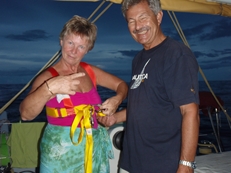Landfall in the Cook Islands

|
20:01.008S 158:05.627W On Wednesday, we welcomed Charles and Susie aboard
from their colourful experience on a cargo ship bringing them from
The next morning, just before we left
the lagoon in Bora Bora, a huge manta ray leapt several feet out of the water
only 30 feet or so from where Rumpelteazer was anchored. And not long afterwards, as we motored
out from the pass and back into the Pacific, we saw a large pod of whales – our
counting was erratic, with Pippa seeing 15 and Andy 9 - which passed us around
100 yards away. We felt these to be
memorable farewells from a lovely island.
Since we left Yesterday, Saturday, was a weird day,
weather-wise, with almost cyclonic conditions. Beginning during the early hours, we had
a day of thunder and lightning, and incessant rain squalls, some of them
bringing no wind and others bringing winds of up to 25 knots, from varying
directions. At times we all retreated "indoors",
sitting in the saloon with the door and windows firmly closed to keep out the
rain. But the good news was that we
eventually got some stable wind, around 15 to 22 knots from the south east, and
were able to sail on a fast port reach during most of the evening and night,
despite the continuing rain squalls. Captain Robert deemed that we deserved a rest, and
anyway that at speeds of 9 knots we were likely to arrive at
Life on Rumpelteazer has settled back
into its routine, with Charles and Susie taking over what had been Max’s watch
and fishing duties. So far, Susie
has not been successful in the fishing department, but she has been seen reading
the fishing book which had been of such help to Max. We are all optimistic! She has however proved to be a great
first-aider, prescribing antibiotics to tackle Pippa’s infected foot. Robert had been seen changing the blade
on his hacksaw in anticipation of an amputation. Charles has proved a dab hand at electronics, and in
understanding complicated and misleading instruction manuals, and he and Robert
have enjoyed themselves sorting the tachometers for both engines. They installed and re-calibrated a new
tachometer, brought by Charles from the
We leave here this afternoon, and our next landfall
will be |
